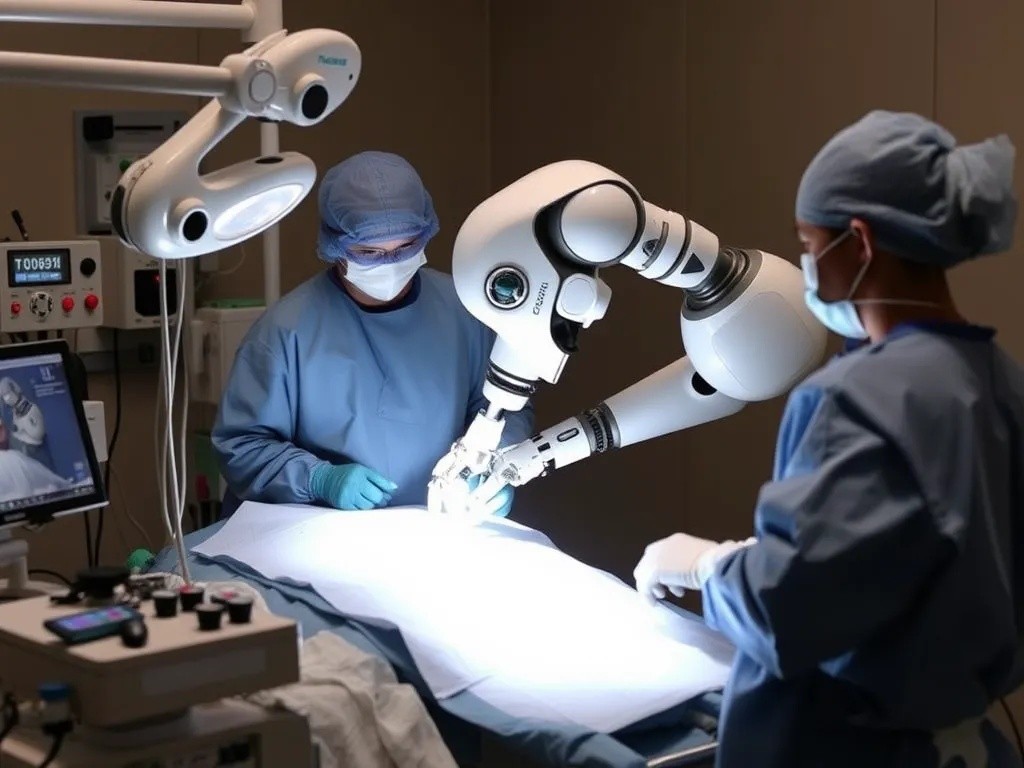In recent years, there has been a significant advancement in the field of Artificial Intelligence (AI) and Augmented Reality (AR). These technologies have become increasingly popular and have the potential to enhance virtual experiences in various fields such as gaming, education, healthcare, and...
Robot Performed Surgery on a Patient Independently for the First Time

In a groundbreaking achievement that represents a transformative leap in medical robotics, researchers at Johns Hopkins University have successfully demonstrated the first truly autonomous surgical robot capable of performing complex procedures without human intervention. The robot operated for the first time on a lifelike patient, and during the operation, responded to and learned from voice commands from the team—like a novice surgeon working with a mentor.
The Revolutionary SRT-H System
The new system, called Hierarchical surgical robot transformer, SRT-H, truly performs surgery, adapting to individual anatomical features in real-time, making decisions on the fly, and self-correcting when things don't go as expected. This advancement represents a significant evolution from previous surgical robots that merely assisted human surgeons.
Built with the same machine learning architecture that powers ChatGPT, SRT-H is also interactive, able respond to spoken commands ("grab the gallbladder head") and corrections ("move the left arm a bit to the left"). The robot learns from this feedback.
Key Capabilities
- Real-time adaptation to individual anatomical features
- Decision-making during unexpected surgical scenarios
- Self-correction when procedures don't go as planned
- Voice command recognition and learning from feedback
- 100% accuracy in complex surgical procedures
The Historic Gallbladder Surgery
The milestone procedure involved a complex gallbladder removal that required the robot to execute 17 different surgical tasks in sequence. The robot had to identify certain ducts and arteries and grab them precisely, strategically place clips, and sever parts with scissors.
SRT-H learned how to do the gallbladder work by watching videos of Johns Hopkins surgeons doing it on pig cadavers. The team reinforced the visual training with captions describing the tasks. After watching the videos, the robot performed the surgery with 100% accuracy.
Training Methodology
The robot's training process represents a revolutionary approach to surgical education for artificial intelligence:
- Video-based learning from expert surgeon demonstrations
- Caption-enhanced visual training for context understanding
- Imitation learning framework for complex procedure automation
- Progressive skill development similar to human surgical residents
Evolution from Previous Robotic Surgery
This breakthrough builds upon years of development in surgical robotics. In 2022, Krieger's Smart Tissue Autonomous Robot, STAR, performed the first autonomous robotic surgery on a live animal—a laparoscopic surgery on a pig. But that robot required specially marked tissue, operated in a highly controlled environment, and followed a rigid, predetermined surgical plan.
Lead researcher Axel Krieger explained that the previous system "was like teaching a robot to drive along a carefully mapped route," while the new system "is like teaching a robot to navigate any road, in any condition, responding intelligently to whatever it encounters."

Performance and Adaptability
The robot performed unflappably across trials and with the expertise of a skilled human surgeon, even during unexpected scenarios typical in real life medical emergencies. The system demonstrated remarkable resilience when faced with challenging conditions:
- Adaptation to non-uniform anatomical conditions
- Performance during unexpected procedural detours
- Successful operation when starting positions were altered
- Continued effectiveness despite visual changes from blood-like dyes
Implications for the Future of Surgery
"This advancement moves us from robots that can execute specific surgical tasks to robots that truly understand surgical procedures," said medical roboticist Axel Krieger. "This is a critical distinction that brings us significantly closer to clinically viable autonomous surgical systems that can work in the messy, unpredictable reality of actual patient care."
Addressing Critical Healthcare Challenges
The development comes at a crucial time when healthcare systems worldwide face significant challenges. A 2024 report by the Association of American Medical Colleges predicted a U.S. shortage of up to 19,900 surgeons by the year 2036. Autonomous surgical robots could help address this shortage while ensuring consistent, high-quality care.
Technical Innovation and Safety
"This work represents a major leap from prior efforts because it tackles some of the fundamental barriers to deploying autonomous surgical robots in the real world," said lead author Ji Woong "Brian" Kim, a former postdoctoral researcher at Johns Hopkins who's now with Stanford University.
The research, published in Science Robotics, demonstrates that artificial intelligence models can achieve the reliability necessary for surgical autonomy—a capability that was previously considered distant but is now demonstrably viable.
Future Development Plans
The research team has ambitious plans for expanding the system's capabilities:
- Training on additional types of surgical procedures
- Expanding capabilities for complete autonomous surgeries
- Further refinement of real-time adaptation algorithms
- Integration with existing surgical infrastructure
Conclusion
This milestone achievement represents more than just a technological advancement—it signals the beginning of a new era in surgical care. "To me it really shows that it's possible to perform complex surgical procedures autonomously," Krieger said. "This is a proof of concept that it's possible and this imitation learning framework can automate such complex procedure with such a high degree of robustness."
As autonomous surgical robots transition from laboratory settings to clinical applications, they promise to revolutionize healthcare delivery, improve surgical outcomes, and provide access to expert-level surgical care regardless of geographic location or surgeon availability. The successful demonstration of independent robotic surgery marks a pivotal moment in the evolution of medical technology and patient care.



